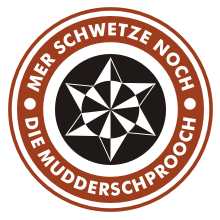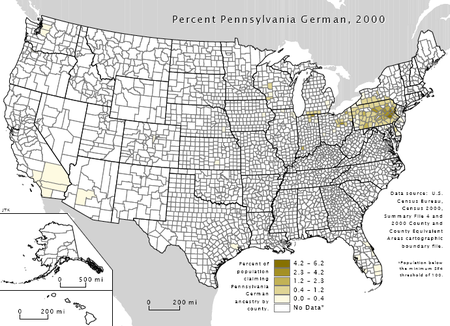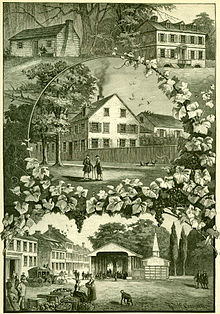Pennsylvania Dutch
 Mer schwetze noch die Mudderschprooch "We still speak the mother tongue" |
| Regions with significant populations |
|---|
| United States, especially Pennsylvania, Ohio, Indiana, Maryland, Virginia, North Carolina, West Virginia; Canada, especially Ontario |
| Languages |
|
English, Pennsylvania Dutch |
| Religion |
|
Lutheran, Reformed, Evangelical, Moravian, Church of the Brethren, Mennonite, Amish, Schwenkfelder, River Brethren, Yorker Brethren |
| Related ethnic groups |
|
Palatine German, Alsatian, Swiss German, Hessian, Württemberger, |
Pennsylvania Dutch refers to immigrants and their descendants from southwestern Germany and Switzerland who settled in Pennsylvania in the 17th and 18th centuries. Historically they have spoken the dialect of German known as Pennsylvania Dutch or Pennsylvania German.
The word Dutch is a variant form of 'deutsch' and only over time has acquired its distinct English meaning referring to the language and people from the Netherlands that historically was part of the Holy Roman Empire of German Nation and ethnically German. [1][2][3] Etymologically, the word dutch originates from the Old High German word diutisc (from diot "people"), referring to the Germanic "language of the people" as opposed to Latin, the language of the learned (see also theodiscus). Only later did the word come to refer to the people who spoke the language. [4] Other Germanic language variants for 'deutsch/deitsch/dutch' are: Dutch Duits, Yiddish daytsh, Danish tysk, Norwegian tysk, and Swedish tyska.[5] The Pennsylvania Dutch dialect is primarily a derivative of Palatinate German.[6] The Pennsylvania Dutch are not the Dutch people from the Netherlands.[7] The English term Germans is only attested from the mid-16th century, based on the classical Latin term Germani used by Julius Caesar and later Tacitus. It gradually replaced the terms 'Dutch' and 'Almains', the latter becoming mostly obsolete by the early 18th century. [8]
Contents[hide] |
[edit] Geography
The Pennsylvania Dutch live primarily in Southeastern and South Central Pennsylvania in the area stretching in an arc from Bethlehem and Allentown through Reading, Lebanon, and Lancaster to York and Chambersburg. They can also be found down throughout the Shenandoah Valley (the modern Interstate 81 corridor) in the adjacent states of Maryland, Virginia, West Virginia and North Carolina, and in the large Amish and Mennonite communities in Mifflin County, Pennsylvania, in Ohio north and south of Youngstown and in Indiana around Elkhart.
[edit] Pennsylvania Dutch from the Palatinate of the Rhine
Many Pennsylvania Dutch are descendants of refugees from the Palatinate of the German Rhine. For example, some Amish and Mennonites came to the Palatinate and surrounding areas from the German-speaking part of Switzerland, where, as Anabaptists, they were persecuted, and so their stay in the Palatinate was of limited duration.[9] However, for the majority of the Pennsylvania Dutch, their roots go much further back in the Palatinate. During the War of the Grand Alliance (1689–97), French troops pillaged the Palatinate, forcing many Germans to flee. The War of the Palatinate (as it was called in Germany), also called the War of Augsburg, began in 1688 as Louis took claim of the Palatinate, and all major cities of Cologne were devastated. By 1697 the war came to a close with the Treaty of Ryswick, now Rijswijk in the Netherlands, and the Palatinate remained free of French control. However, by 1702, the War of Spanish Succession began, lasting until 1713. French expansionism forced many Palatines to flee as refugees.[10]The first major emigration of Germans to America resulted in the founding of the Borough of Germantown in northwest Philadelphia County, Pennsylvania in 1683-1685. Mass emigration of Palatines began out of Germany in the early 18th century. In the spring of 1709, Queen Anne had granted refuge to about 7,000 Palatines who had sailed the Rhine to Rotterdam. From here about 3,000 were sent to America either directly, or through England, bound for William Penn's colony. The remaining refugees were sent to Ireland to strengthen the Protestant presence in the country. By 1710, large groups of Palatines had sailed from London, the last group of which was bound for New York. There were 3,200 Palatines on 12 ships that sailed for New York and approximately 470 died en route to America. In New York, under the new Governor, Robert Hunter, Palatines lived in camps and worked for British authorities to produce tar and pitch for the Royal Navy in return for their safe passage. They also served as a buffer on the frontier separating the French and Native Americans from the English colonies. In 1723, some 33 Palatine families, dissatisfied under Governor Hunter's rule, migrated from Schoharie, New York, along the Susquehanna River to Tulpehocken, Berks County, Pennsylvania, where other Palatines had settled. They became farmers and used intensive German farming techniques that proved highly productive.[11]
[edit] 18th century
The Pennsylvania Dutch composed nearly half the population of Pennsylvania and generally supported the American Revolution. Henry Miller, an immigrant from Germany of Swiss ancestry, published an early German translation of the Declaration of Independence in his newspaper Philadelphische Staatsbote. Miller often wrote about Swiss history and myth, such as the William Tell legend, to provide a context for Patriot support in the conflict with Britain.[12]
Frederick Muhlenberg (1750-1801), a Lutheran pastor, became a major Patriot and politician, rising to Speaker of the U.S. House of Representatives.
[edit] Religion
The Pennsylvania Dutch are a people of various religious affiliations, most of them Lutheran or Reformed, but many Anabaptists as well. Henry Muhlenberg (1711-1787) founded the Lutheran Church in America. He organized the Ministerium of Pennsylvania in 1748, set out the a standard organizational format for new churches, and helped shape Lutheran liturgy. [13]
Muhlenberg had been sent by the Lutheran bishops in Germany and he always insisted on strict conformity to Lutheran dogma. Muhlenberg's view of church unity was in direct opposition to Nicolaus Ludwig Zinzendorf's Moravian approach with its goal of uniting various Pennsylvania German religious groups under a less rigid "Congregation of God in the Spirit." The differences between the two approaches led to permanent impasse between Lutherans and Moravians, especially after a December 1742 meeting in Philadelphia.[14]
[edit] See also
- Amish
- Mennonite
- Schwenkfeldian
- Old German Baptist Brethren
- Pennsylvania German language
- Hex sign
- Pennsylvania Dutch Country
- Hiwwe wie Driwwe. newspaper
- Pennsylvania Dutch cuisine
- German American
- Helen Reimensnyder Martin, author
- Anna Balmer Myers, author
- Fraktur (Pennsylvania German folk art)
- Kurrent handwriting
| Pennsylvania Dutch edition of Wikipedia, the free encyclopedia |
[edit] References
- ^ http://en.wikipedia.org/wiki/Deutsch retrieved Nov. 3, 2011
- ^ Hostetler, John A. (1993), Amish Society, The Johns Hopkins University Press, Baltimore, p. 241.
- ^ De Grauwe, Luc, "Emerging mother-tongues awareness in Dutch and German". In Linn & McLelland (eds). Standardization: Studies from the Germanic Languages. p.101, 104, passim.
- ^ http://en.wikipedia.org/wiki/Deutsch retrieved Nov. 3, 2011 citing to Paul, Hermann. 1960. Deutsches Wörterbuch (siebente Auflage): "Deutsch"
- ^ http://en.wikipedia.org/wiki/Theodiscus retrieved Nov. 3, 2011
- ^ Online Etymological Dictionary
- ^ Pennsylvania Dutch Are Of German Heritage, Not Dutch
- ^ http://en.wikipedia.org/wiki/Germans retrieved Nov. 3, 2011, citing to ^ Schulze, Hagen (1998). Germany: A New History. Harvard University Press. p. 4. ISBN 0-674-80688-3 and ^ "German", The Concise Oxford Dictionary of English Etymology. Ed. T. F. Hoad. Oxford: Oxford University Press, 1996. Oxford Reference Online. Oxford University Press. Retrieved 4 March 2008.
- ^ Newman, George F., Newman, Dieter E. (2003) The Aebi-Eby Families of Switzerland, Germany, Austria, and North America, 1550-1850. Pennsylvania: NMN Enterprises
- ^ Roeber 1988
- ^ Farley Grubb, "German Immigration to Pennsylvania, 1709 to 1820," Journal of Interdisciplinary History Vol. 20, No. 3 (Winter, 1990), pp. 417-436 in JSTOR
- ^ A. G.. Roeber, "Henry Miller's Staatsbote: A Revolutionary Journalist's Use of the Swiss Past," Yearbook of German-American Studies, 1990, Vol. 25, pp 57-76
- ^ Leonard R. Riforgiato, Missionary of moderation: Henry Melchior Muhlenberg and the Lutheran Church in America (1980)
- ^ Samuel R. Zeiser, "Moravians and Lutherans: Getting beyond the Zinzendorf-Muhlenberg Impasse," Transactions of the Moravian Historical Society, 1994, Vol. 28, pp 15-29
[edit] Bibliography
- Grubb, Farley. "German Immigration to Pennsylvania, 1709 to 1820," Journal of Interdisciplinary History Vol. 20, No. 3 (Winter, 1990), pp. 417-436 in JSTOR
- McMurry, Sally, and Nancy Van Dolsen, eds. Architecture and Landscape of the Pennsylvania Germans, 1720-1920 (University of Pennsylvania Press; 2011) 250 studies their houses, churches, barns, outbuildings, commercial buildings, and landscapes
- Nolt, Steven, Foreigners in Their Own Land: Pennsylvania Germans in the Early American Republic, Penn State U. Press, 2002 ISBN 0-271-02199-3
- Roeber, A. G. Palatines, Liberty, and Property: German Lutherans in Colonial British America (1998)
- Roeber, A. G. "In German Ways? Problems and Potentials of Eighteenth-Century German Social and Emigration History," William & Mary Quarterly, Oct 1987, Vol. 44 Issue 4, pp 750-774 in JSTOR
[edit] External links
- The Pennsylvania German Society
- Lancaster County tourism website
- Overview of Pennsylvania German Culture
- German-American Heritage Foundation of the USA in Washington, DC
- "Why the Pennsylvania German still prevails in the eastern section of the State", by George Mays, M.D.. Reading, Pa., Printed by Daniel Miller, 1904
- The Schwenkfelder Library & Heritage Center
- FamilyHart Pennsylvania Dutch Genealogy Family Pages and Database
- Pennsylvania Dutch Family History, Genealogy, Culture, and Life
[edit] In Pennsylvania German
- Deitscherei.org — Fer der Deitsch Wandel
- Hiwwe wie Driwwe — The Pennsylvania German Newspaper
- Pennsylvania German Encyclopedia
|
||
|
||
|
|||
- Amish
- Culture of Lancaster, Pennsylvania
- Ethnic groups in the United States
- German language
- German-American history
- German American
- American people of German descent
- German diaspora
- Mennonitism in the United States
- Pennsylvania culture
- North Carolina culture
- Virginia culture
- Maryland culture
- Pennsylvania German culture

